L7 Farm
Chirping
Meet beautiful Yetta, our Blue-laced Red Wyandotte. She was a bonus chick in our first spring brood. She's about 21 weeks now...and she started crowing two weeks ago. And we are not allowed to have roosters in our town (the law says roosters, not crowing fowl, fortunately).
Now, in reading other threads here and information about hens crowing on other sites, and asking around a little, I believe she's within the "normal" range of actual hens crowing and not cockrels showing their true colors a bit late. Here's why:
- she only crows for about ten minutes in the morning, after being let out of the coop into the run for the day. It's not quite a full-throated cry (although we don't know the breed, my wife was raised with Rhode Island Reds with plenty of roosters around, so maybe Wyandottes are just more demure) but it's...pretty loud.
- we don't have a rooster (see above, town ordinance).
- there *is* a rooster across the street who's quite audible for much of the day.
- the pecking order is still being settled, as due to a variety of circumstances a bit too long to get into here, we had one brood of three surviving hens, of which she is one, and another brood of five that are four weeks younger, now mixed together in the same yard but overnighting in separate coops. The "oldsters" of 21 weeks are Yetta and two Buff Orpingtons, the "youngsters" of 15 weeks are two Barred Plymouth Rocks and an Olive Egger. But it's one of the Orpingtons who is the "enforcer" with the little chicks and the other Orpington gets first crack at food when she wants to assert herself, which makes me think Yetta is not the top hen. When the little birds catch up with the big ones I assume the pecking order will sort itself out, and in the meantime it's clear the littles are getting more assertive, relatively, as they get relatively bigger.
- BUT....that said, Yetta has never been the assertive one in her half of the flock; she decides when they go to bed, by turning in first, but that's about it. She's the shyest when we give out treats (the Orpingtons and Rockers love to scrum, Yetta and Betsy, our Olive Egger, just hang out at the periphery hoping for scraps to be left over). In short, she hasn't really acted like "top hen" and thus perhaps subject to crowing in the absence of roosters.
- Being a Wyandotte, I do note her tail feathers came in early (not late, as the cockerels are said to be for the breed).
- She is not a "talker", relatively, at least not thus far.
- While a little shy she's super docile and likes to take a perch a few feet away from me and watch me while I clean up, etc., in the yard. Not at all like the cock of the walk, behavior-wise.
Fortunately our neighbors on one side don't care, but unfortunately the neighbors on the other side (who are blissfully away at their camp for another couple of weeks) are pretty much out to get us and our chickens, and I'd love it if this was just a passing phase and not evidence of Roosterhood. Because the town doesn't allow roosters, worst case is we'd have to get rid of "her", and she's....well, I hope it's OK to say she's our favorite.
So I'm attaching photos for more experienced eyes (particularly if you know Red Wyandottes) to either reassure me she's as she or give me the bad news now if she's a cockerel. Apologies as ever for my bad cell phone photography -- I wasn't great to being with and then I had to downgrade my phone/camera.
One theory my wife has hatched (as it were) is she's imitating the rooster across the street -- heard but never seen -- or trying to get his attention, as she's about the right age to come into lay, or nearly old enough, the hormones might be stirring.
Now, in reading other threads here and information about hens crowing on other sites, and asking around a little, I believe she's within the "normal" range of actual hens crowing and not cockrels showing their true colors a bit late. Here's why:
- she only crows for about ten minutes in the morning, after being let out of the coop into the run for the day. It's not quite a full-throated cry (although we don't know the breed, my wife was raised with Rhode Island Reds with plenty of roosters around, so maybe Wyandottes are just more demure) but it's...pretty loud.
- we don't have a rooster (see above, town ordinance).
- there *is* a rooster across the street who's quite audible for much of the day.
- the pecking order is still being settled, as due to a variety of circumstances a bit too long to get into here, we had one brood of three surviving hens, of which she is one, and another brood of five that are four weeks younger, now mixed together in the same yard but overnighting in separate coops. The "oldsters" of 21 weeks are Yetta and two Buff Orpingtons, the "youngsters" of 15 weeks are two Barred Plymouth Rocks and an Olive Egger. But it's one of the Orpingtons who is the "enforcer" with the little chicks and the other Orpington gets first crack at food when she wants to assert herself, which makes me think Yetta is not the top hen. When the little birds catch up with the big ones I assume the pecking order will sort itself out, and in the meantime it's clear the littles are getting more assertive, relatively, as they get relatively bigger.
- BUT....that said, Yetta has never been the assertive one in her half of the flock; she decides when they go to bed, by turning in first, but that's about it. She's the shyest when we give out treats (the Orpingtons and Rockers love to scrum, Yetta and Betsy, our Olive Egger, just hang out at the periphery hoping for scraps to be left over). In short, she hasn't really acted like "top hen" and thus perhaps subject to crowing in the absence of roosters.
- Being a Wyandotte, I do note her tail feathers came in early (not late, as the cockerels are said to be for the breed).
- She is not a "talker", relatively, at least not thus far.
- While a little shy she's super docile and likes to take a perch a few feet away from me and watch me while I clean up, etc., in the yard. Not at all like the cock of the walk, behavior-wise.
Fortunately our neighbors on one side don't care, but unfortunately the neighbors on the other side (who are blissfully away at their camp for another couple of weeks) are pretty much out to get us and our chickens, and I'd love it if this was just a passing phase and not evidence of Roosterhood. Because the town doesn't allow roosters, worst case is we'd have to get rid of "her", and she's....well, I hope it's OK to say she's our favorite.
So I'm attaching photos for more experienced eyes (particularly if you know Red Wyandottes) to either reassure me she's as she or give me the bad news now if she's a cockerel. Apologies as ever for my bad cell phone photography -- I wasn't great to being with and then I had to downgrade my phone/camera.
One theory my wife has hatched (as it were) is she's imitating the rooster across the street -- heard but never seen -- or trying to get his attention, as she's about the right age to come into lay, or nearly old enough, the hormones might be stirring.

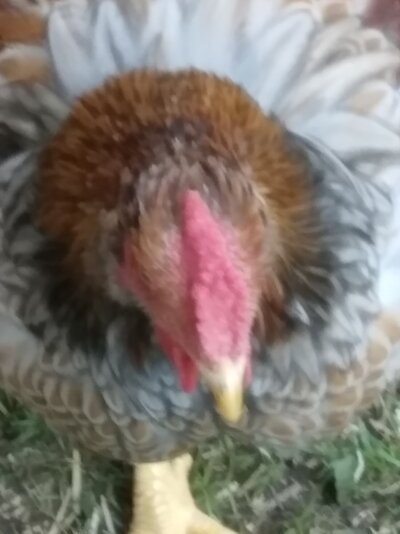
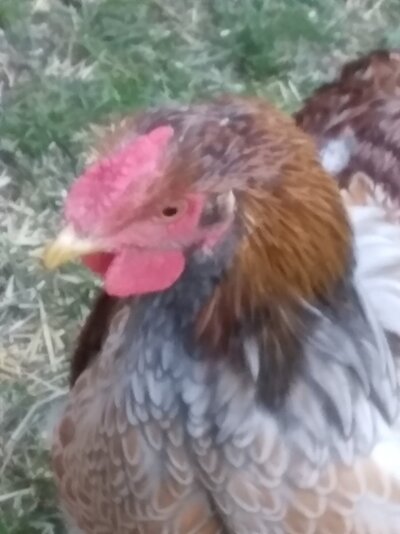
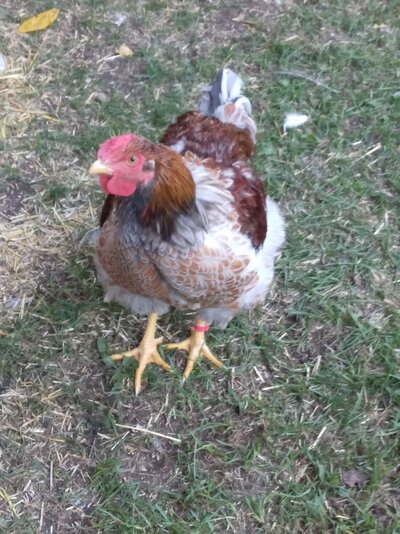
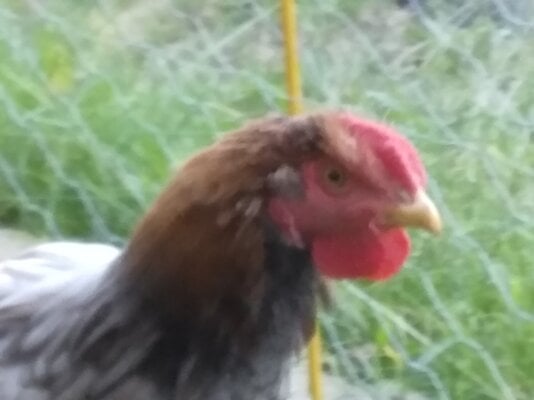
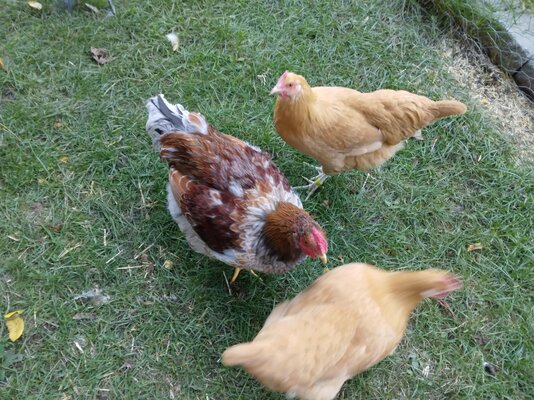



 )
)